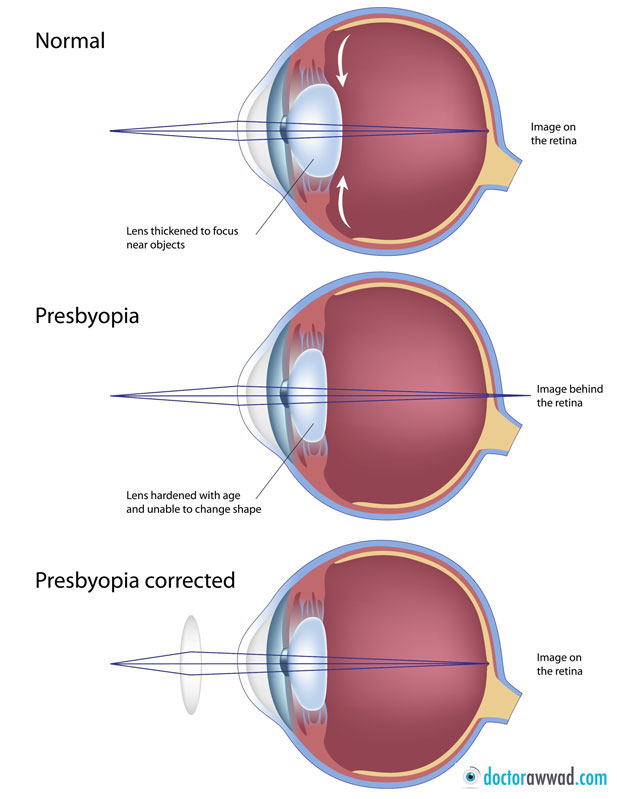What is Presbyopia?
The human eye is designed to see very clearly for far. The near is usually out of focus, unless the eye makes an effort to contract its ciliary muscles, changing the shape of the crystalline lens to become more convex, hence bending light even further and getting the image of a close object on to the retina. Interestingly, the camera works by the exact same mechanism. A camera is designed to take great photos for far objects. For near objects, the camera will need to autofocus else the “macro” mode needs to be on. Presbyopia is the age-related inability of the human eye to “autofocus” for near, due to the weakening of the muscles of the eye’s natural lens. It is most prominent after the age of 40, and progressively gets worse till around age 60. People then have to wear glasses to read the time off their watch, to read and write messages on mobile phones, read newspapers, and work on computers.
[view photos]
Presbyopia vis-a-vis other visual errors
Presbyopia affects all individuals after a certain age-usually 40: people who see perfectly for far, or people with visual error for far (myopia, astigmatism, or hypermetropia), all will experience presbyopia, albeit at different extent. Individuals who have no errors for far (emmetropic) will need around +1.00 D spectacles at the age of 40-42, +1.50 D at the age of 45, +2.00 D at the age of 50, +2.50 D at the age of 55, and +3.00 D at the age of 60 years. Myopic individuals are usually shortsighted; their focal distance is short. Hence, they need to exert no effort to see near objects. Far objects however are out of focus. When a myopic person becomes presbyopic, she or he will notice that reading at near is easier without their myopic glasses, as the latter will correct myopia, and by the same token, take away their advantage for near. A myopic person who is wearing contact lenses and has presbyopia will have to wear presbyopic glasses to see well for near. A hypermetropic individual is far-sighted. She or he is already at a disadvantage for near, as the near is much more blurry than the far. When presbyopia kicks in, she or he will need more powerful correction than the one needed by a person who sees clearly for far, assuming they both have the same age. For instance, if the correction for far is +3.00 D in a 60 year-old lady, she will need to use +6.00 D for near, while a lady with the same age and no visual errors for far will need only +3.00 D for near (and nothing for far).
Optical treatment
Presbyopia can be corrected either optically or surgically. Optically, bifocal and progressive eyeglasses can be prescribed. The latter are spectacles with central correction designed for the far, and then from the center to the inferior periphery, there is an increase in convexity (increase in positive power of the lenses) so they correct the near. This is based on the principle that people usually look down to read at near (newspaper, smartphones), and somehow less (obliquely down) for intermediate (computers), and straight for far (with exceptions, for which the eyeglasses can be tweaked accordingly). Multifocal contact lenses have had variable success in some patients.
Surgical treatment options
Surgically, presbyopia can be corrected using a variety of options, with variable success. Corneal inlays, like the small aperture inlay (KAMRA inlay) are a great option for people between 45 to 65 years with no other eye problem. The latter consists on implanting, in the non-dominant eye, a circular thin tissue that acts as a pin-hole to improve the vision for near and intermediate, while maintaining the vision for far. Another alternative is LASIK monovision (full or partial), which attempts to correct one eye fully for far, and make the other, non-dominant eye, sharper for near. With both eyes open, the patient sees both for far and for near. Other options include presbyLASIK, which attempts to create a multifocal cornea via the laser, and hence improve the vision both far and near. Finally, if an individual has cataract, even if it’s mild, then a cataract surgery can be performed and a multifocal intraocular lens, among others, can be implanted to improve the vision both for far and for near. In all the treatment modalities, the patient needs to be aware that presbyopia cannot be cured, at least till now. We can only improve it, albeit in many instances dramatically well.


